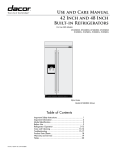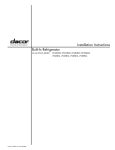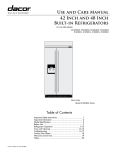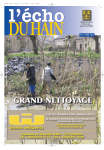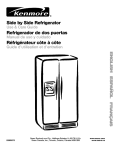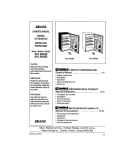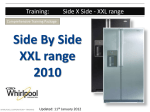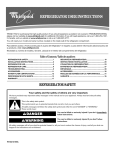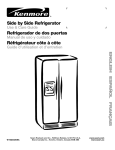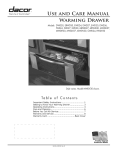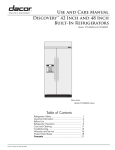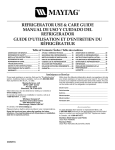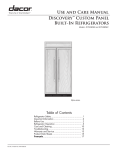Download Dacor 103674H Product data
Transcript
U SE AND
The Life of the Kitchen. _
CARE MANUAL
42 INCH
BUILT-IN
AND
48 INCH
REFRIGERATORS
Models: EF42DBSS, EF42NBSS, EF48DBSS, EF48NBSS
IF42DBOL, IF42NBOL, IF48DBOL, IF48NBOL
I
I
Style varies.
Model EF42DBSS
Table of Contents
Refrigerator Safety .........................................................
Important Information .....................................................
Model Identification .......................................................
Before Use ....................................................................
Refrigerator Operation ..............................................
Care and Cleaning .................................................
Troubleshooting ......................................................
Product Data Sheets .....................................................
Warranty and Service ..................................................
Notes .........................................................................
Franc, ais ...............................................................
PartNo.
103674
Rev. H/W10303784
1
2
2
3
3-12
13-14
15-17
18
19
20
21-44
shown.
To Our Valued Customer:
Congratulations
performance
on your purchase of the very latest in Dacor * products! Our unique combination of features, style and
make us The Life of the Kitchen =, and a great addition to your home.
In order to familiarize yourself with the controls, functions and full potential of your new Distinctive Appliance, read this
use and care manual thoroughly, beginning with the Important
Safety Instructions
section.
All Dacor appliances are designed and manufactured with quality and pride, while working within the framework of our
company value. Should you ever experience a problem with your product, please first check the Before You Call for
Service section of this manual for guidance. It provides useful suggestions and remedies prior to calling for service.
Valuable customer input helps us to continuously improve our products and services, so please feel free to contact
our Customer Service Team for assistance with any of your product support needs.
Dacor Customer Service Team
600 Anton Blvd. Suite 1000
Costa Mesa, CA 92626
Telephone:
(800) 793-0093
Fax:
(626) 403-3130
Hours of Operation:
Monday through Friday
6:00
Web Site:
A.M, to
5:00
P,M,
Pacific Time
www. Dacor.com
Thank you for choosing Dacor for your home. We are a company built by families for families and we are dedicated
to serving yours.
We are confident that your new Dacor product will deliver a high level of performance and
enjoyment for many years to come.
Sincerely,
The Dacor Customer Service Team
© 2008 Dacor, all rights reserv,_,_
gera
Your safety and the safety of others are very important.
We have provided many important safety messages in this manual and on your appliance. Always read and obey all safety
messages.
This is the safety alert symbol.
This symbol alerts you to potential hazards that can kill or hurt you and others.
All safety messages will follow the safety alert symbol and either the word "DANGER" or "WARNING."
These words mean:
You can be killed or seriously injured if you don't immediately
follow instructions.
You can be killed or seriously injured if you don't follow
instructions.
All safety messages will tell you what the potential hazard is, tell you how to reduce the chance of injury, and tell you what can
happen if the instructions are not followed.
IMPORTANT SAFETY INSTRUCTIONS
WARN ING"
To reduce the risk of fire, electric shock, or injury when using your refrigerator, follow these basic precautions:
• Plug into a grounded
• Use nonflammable
3 prong outlet.
• Do not remove ground prong.
• Keep flammable materials and vapors, such as gasoline,
away from refrigerator.
• Do not use an adapter.
• Do not use an extension cord.
• Disconnect
• Use two or more people to move and install refrigerator.
power before servicing.
• Replace all parts and panels before operating.
• Disconnect power before installing ice maker (on ice maker
kit ready models only).
• Use a sturdy glass when dispensing
• Remove doors from your old refrigerator.
SAVETHESEINSTRUCTIONS
Proper Disposal of Your Refrigerator
Suffocation Hazard
Remove doors from your old refrigerator.
Failure to do so can result in death or brain damage.
IMPORTANT: Child entrapment and suffocation are not problems
of the past. Junked or abandoned refrigerators are still dangerous,
even if they sit out for "just a few days." If you are getting rid of
your old refrigerator, please follow the instructions below to help
prevent accidents.
Before you throw
away your old refrigerator
cleaner.
or freezer:
•
Take off the doors.
•
Leave the shelves in place so children may not easily climb
inside.
ice (on some models).
Installer:Please
leavethisguidewiththisappliance.
Have complete model and serial number identification of your
refrigerator
ready. These numbers are found on a serial number
Consumer:
Please
readandkeepthisuseandcaremanual
for
located on the right side of the refrigerator liner. Record
futurereference.
Thisguideprovides
properuseandmaintenancelabel,
these numbers on this page for easy access.
information.
Keepthisguideand the sales receipt andl
or cancelled check together for future reference. Proof of
original purchase date is needed for warranty service.
Model number
Serial number
IMPORTANT: If you receive a damaged product, immediately
contact your dealer or builder. Do not install or use a damaged
appliance.
Date of purchase
If you have any questions, call:
Since Dacor constantly improves the quality and performance of
our products, we may need to make changes to the appliance
without revising this manual.
Dacor Customer Service
(800) 793-0093 (U.S.A. and Canada)
Monday -- Friday 6:00 A.M.to 5:00 P.M. Pacific Time
For service and warranty information,
Web site: www.Dacor.com
EF42DBSS and EF48DBSS:
IF42DBOL and IF48DBOL:
42" and 48" dispenser models
with all stainless steel finish
42" and 48" dispenser models
designed for installation of custom
panels and handles
EF42NBSS and EF48NBSS:
IF42NBOL and IF48NBOL:
42" and 48" non-dispensing
models with all stainless steel
finish
42" and 48" non-dispensing
models designed for installation of
custom panels and handles
see page 19.
Remove the Packag,[ng
Clean Before Using
•
Remove tape and glue residue from surfaces before turning on
the refrigerator. Rub a small amount of liquid dish soap over
the adhesive with your fingers. Wipe with warm water and dry.
After you remove all of the packaging materials, clean the inside
of your refrigerator before using it. See the cleaning instructions in
Care and Cleaning.
•
Do not use sharp instruments, rubbing alcohol, flammable
fluids or abrasive cleaners to remove tape or glue. These
products can damage the surface of your refrigerator. For
more information, see Important Safety Instructions on page 1.
•
Dispose of/recycle all packaging materials.
Turning the Main Power Switch On/Off
Important information
covers:
to know about glass shelves and
Do not clean glass shelves or covers with warm water when
they are cold. Shelves and covers may break if exposed to
sudden temperature changes or impact, such as bumping.
Tempered glass is designed to shatter into many small,
pebble-size pieces. This is normal. Glass shelves and covers
are heavy. Use both hands when removing them to avoid
dropping.
Removing the Top Grille
1. Grasp both ends of the top grille.
2.
Push the top grille straight up, then pull straight out. Lay the
grille on a soft surface.
B
A
B
Electrical Shock Hazard
Plug into a grounded 3 prong outlet.
Do not remove ground prong.
A. Top grille
B Cabinet side trim
Do not use an adapter.
Do not use an extension cord.
Failure to follow these instructions can result in death,
fire, or electrical shock.
Replacing
the Top Grille
1. Insert the top grille hooks (located on the back of the top grille)
into the slots on the side trim.
2.
Pull the grille down slightly to lock into place.
To Turn the Main
Power
Switch
On or Off:
1. Remove the top grille.
2.
Press the main power switch to the ON or OFF position.
3. Replace the top grille.
Explosion Hazard
Keep flammable materials and vapors, such as
gasoline, away from refrigerator.
IMPORTANT: Be sure the main
power switch is set to the On
position after cleaning refrigerator
or changing light bulbs.
Failure to do so can result in death, explosion, or fire.
If you need to turn the power to your refrigerator on or off,
you must remove the top grille assembly to access the power
switch. Turn the power to the refrigerator off when cleaning your
refrigerator or changing light bulbs.
A. Power switch
A
Water Supp!y ,,,Requ
ireme nts
Read all directions before you begin.
IMPORTANT:
•
For dispensing models, the On/Off switch is located on the top
right side of the freezer compartment.
1. Open the freezer door and turn off the ice maker. Move the
switch to the OFF (right) setting as shown.
When your refrigerator was installed, the water connection
from the water source should have been connected to your
refrigerator. If your refrigerator is not connected to a water
source, see Connect the Water Supply in the installation
instructions. If you have any questions about your water
connection, see the Troubleshooting section or call a licensed,
qualified plumber.
•
If you turn the refrigerator on before the water line is
connected, turn the ice maker OFF. See Ice Maker and
Storage Bin on page 8.
•
All installations
Water
Pressure
Osmosis
Water
Supply
IMPORTANT: The pressure of the water supply coming out of
a reverse osmosis system going to the water inlet valve of the
refrigerator needs to be between 30 and 120 psi (207 and 827
kPa).
If a reverse osmosis water filtration system is connected to your
cold water supply, the water pressure to the reverse osmosis
system needs to be a minimum of 40 psi (276 kPa).
2. Use a sturdy container to depress and hold the water
dispenser lever for 5 seconds, then release it for 5 seconds.
Repeat until water begins to flow. Once water begins to flow,
continue depressing and releasing the dispenser lever (5
seconds on, 5 seconds off) until a total of 3 gal. (12 L) has
been dispensed. This will flush air from the filter and water
dispensing system, and prepare the water filter for use.
Additional flushing may be required in some households.
NOTE: As air is cleared from the system, water may spurt out
of the dispenser.
3. Open the freezer door and turn on the ice maker. Move the
switch to the ON (left) position.
• Allow 24 hours to produce the first batch of ice.
If the water pressure to the reverse osmosis system is less than
40 psi (276 kPa):
•
Maker
must meet local plumbing code requirements.
A cold water supply with water pressure between 30 and 120 psi
(207 and 827 kPa) is required to operate the water dispenser and
ice maker. If you have questions about your water pressure, see
Troubleshooting or call a licensed, qualified plumber.
Reverse
Ice
•
Discard the first three batches of ice produced.
•
Depending on your model, you may want to select the
maximum ice feature to increase the production of ice.
Check to see whether the sediment filter in the reverse
osmosis system is blocked. Replace the filter if necessary.
Style 2 - Non-Dispenser
•
Allow the storage tank on the reverse osmosis system to refill
after heavy usage.
IMPORTANT: After connecting the refrigerator to a water source
or replacing the water filter, fill and discard two full containers of
ice to prepare the water filter for use, before using the ice:
•
If your refrigerator has a water filter, it may further reduce
the water pressure when used in conjunction with a reverse
osmosis system. Remove the water filter. See Replacing the
Water Filter on page 14.
If you have questions about your water pressure, call a licensed,
qualified plumber.
Water System Preparation
•
Turn on the ice maker. Lower the wire shutoff arm as shown.
Please refer to "Ice Maker and Storage Bin" for further
instructions on the operation of your ice maker.
NOTE:
• Allow 24 hours to produce the first batch of ice.
• Allow 3 days to completely fill ice container.
•
unknown quality without adequate disinfection before or after
system.
Systems
for cyst reductionunsafe
may be
on
I the
o not
use with
water certified
that Js mJcrobiologicalty
or used
of
disinfected waters that may contain filterable cysts.
Please read before using the water system. Follow the directions
specific to your model.
NOTE: If your model has a base grille filter system, make sure
the base grille filter is properly installed and the cap is in the
horizontal position.
Style 1 - Dispenser
Models
IMPORTANT: After connecting the refrigerator to a water source
or replacing the water filter, follow these steps to make sure that
the water system is properly cleaned. This wilt flush air from the
filter and water dispensing system, and prepare the filter for use.
Models
Depending on your model, you may want to select the
maximum ice feature to increase the production of ice.
Ice maker cover
\
Normal Operating Sounds
Setting the Controls
Your new refrigerator may make sounds that your old one
didn't make. Because the sounds are new to you, you might be
concerned about them. Most of the new sounds are normal. Hard
surfaces, such as the floor, walls and cabinets, can make the
sounds seem louder. The following describes the kinds of sounds
and what may be making them.
The control panel is located inside the refrigerator compartment
on the ceiling.
•
•
•
IMPORTANT:
The refrigerator control adjusts the refrigerator compartment
temperature. The freezer control adjusts the freezer
compartment temperature.
If your refrigerator is equipped with an ice maker, you will hear
a buzzing sound when the water valve opens to fill the ice
maker for each cycle.
Your refrigerator is designed to run more efficiently to keep
your food items at the desired temperatures and to minimize
energy usage. The high efficiency compressor and fans may
cause your refrigerator to run longer than your old one. You
may also hear a pulsating or high-pitched sound from the
compressor or fans adjusting to optimize performance.
You may hear the evaporator fan motor circulating air through
the refrigerator and freezer compartments. The fan speed may
increase as you open the doors or add warm food.
•
Rattling noises may come from the flow of refrigerant, the
water line or items stored on top of the refrigerator.
•
Water dripping on the defrost heater during a defrost cycle
may cause a sizzling sound.
•
As each cycle ends, you may hear a gurgling sound due to the
refrigerant flowing in your refrigerator.
•
Contraction and expansion of the inside walls may cause a
popping noise.
•
You may hear air being forced over the condenser by the
condenser fan.
Wait 24 hours after you turn on the refrigerator before you put
food into it. If you add food before the refrigerator has cooled
completely, your food may spoil.
NOTE: Adjusting the refrigerator and freezer controls to a
lower (colder) setting will not cool the compartments any
faster.
•
If the temperature is too warm or too cold in the refrigerator
or freezer, first check the air vents to be sure they are not
blocked before adjusting the controls.
•
The preset settings should be correct for normal household
usage. The controls are set correctly when milk or juice is as
cold as you like and when ice cream is firm.
•
The actual temperature may differ from the display when a
door is open for an extended period of time.
NOTE: The factory recommended settings are 0°F (-18°C) for the
freezer and 37°F (3°C) for the refrigerator.
Turning the Refrigerator
On or Off
•
Press and hold the POWER ON-OFF key for 2 seconds.
When the refrigerator comes on, the freezer and refrigerator
temperature displays will light.
•
To turn the refrigerator off, press and hold the POWER
ON-OFF key for 2 seconds. The freezer and refrigerator
temperature displays will go dark when the refrigerator is off.
You may hear water running into the drain pan during the
defrost cycle.
Ensuring...Proper Air Circulation
In order to ensure proper temperatures, you need to permit
airflow between the two sectJons. Cold air enters the bottom of
the freezer section and moves up. It then enters the refrigerator
sectJon through the top vent. Air then returns to the freezer as
shown.
Do not block any airflow vents. If the vents are blocked, airflow
will be obstructed and temperature and moisture problems may
occur.
IMPORTANT: Because air
circulates between both sections,
any odors formed in one section
wilt transfer to the other. You
must thoroughly clean both
sections to eliminate odors. To
avoid odor transfer and drying
out of food, wrap or cover foods
tightly.
NOTE:
After the refrigerator is turned on, the over temperature audio
alarm and indicator light wilt activate every 1½ hours until the
refrigerator and freezer temperatures are below 48°F (9°C)
and 15°F (-9°C), respectively, or until the alarm is turned off.
To turn off the audio alarm and indicator light, see Master
Alarm Reset on page 7.
Over temperature
indicator light
i
H
IIIIIIIIIIII
/j
The Power ON-OFF key on the control panel shuts down the
cooling system, fans and compressors as well as the control
panel lights. To turn the power off completely, use the main
power switch located behind the top grille. See page 3.
Water
Setjjng the Controls (continued)
Setting the Temperature Scale
•
Filter Monitor
microbiologicalty
use
The indicator light, next to the C ° button, is lit when the
temperature scale for the freezer and refrigerator displays is
set to Celsius. To change the displays to Celsius (or back to
Fahrenheit), press the C ° button.
Celsius indicator light
or
unknown quality without adequate disinfection before or after
system. with
Systems
may be used
on
I the
Do not
water certified
that is for cyst reductionunsafe
of
disinfected waters that may contain filterable cysts.
The water filter monitor wilt help you know when it is time to
change your filter. To change the filter, see the Replacing the
Water Filter on page 14.
DISPLAY READING:
STATUS:
99 percent
New filter installed
10 percent
Order replacement filter
0 percent or flow decreases
Replace filter
NOTE: The adjustable temperature range for the freezer is -5°F
to 6°F (-21°C to -14°C). The adjustable temperature range for the
refrigerator is 34°F to 46°F (1°C to 8°C).
A new water filter should display
a reading of 99%. The reading in
the display will decrease as the
filter life is used. When the display
reads 10%, it is time to order
a replacement water filter. It is
recommended that you replace the
filter when the filter display changes
to 0% OR when water flow to
your water dispenser or ice maker
decreases noticeably. See Replacing the Water Filter on page 14.
Use the table below for guidance if you need to change the
temperature.
After replacing the water filter, press RESET and hold for 2
seconds to change the water filter display to 99 percent.
Adjusting
the Temperature
Setting
NOTE: Wait at least 24 hours between adjustments.
temperatures before other adjustments are made.
To adjust
•
the temperature
Re-check the
setting:
Press the refrigerator or freezer UP (A) or DOWN (V) key
until the desired temperature is reached.
CONDITION/
TEMPERATURE
REASON:
ADJUSTMENT:
REFRIGERATOR
too cold
REFRIGERATOR
Not set correctly for conditions
higher
REFRIGERATOR
REFRIGERATOR
too warm
Control 1°
Control 1° lower
High use or room very warm
FREEZER too cold
Not set correctly for conditions
FREEZER
Control 1° higher
FREEZER too warm/too
FREEZER
Control 1° lower
little ice.
High use or heavy ice use
Max Cool
The Max Cool feature assists with periods of heavy ice usage, full
grocery loads or temporarily warm room temperatures.
Press the MAX COOL key to turn on the Max Cool feature.
The Max Cool indicator light will remain on for 24 hours unless
manually turned off.
NOTE: The refrigerator temperature display will remain at 34°F
(1°C) and the freezer temperature display wilt remain at -5°F
(-21°C) while the Max Cool feature is on. After 24 hours, the
refrigerator will automatically return to the previous temperature
settings.
Max cool indicator
light
Holiday
Mode
Door
Open
The Holiday Mode feature is designed for the traveler or for
those whose religious observances require turning off the lights
and ice maker. When you select this feature, the ice maker will
be disabled and the interior lights will turn off. The temperature
settings remain unchanged. On some models, the Holiday Mode
feature doesn't disable the ice and water dispenser. For these
models the lock button can be used to disable the ice and water
functions, but depressing the ice or water lever wilt still turn on
the dispenser light. For most efficient refrigerator operation, it
is recommended to exit the Holiday Mode when it is no longer
required.
The Door Open indicator light wilt flash, an
alarm wilt sound and the interior lights wilt turn
off when a door has been open for longer than
10 minutes. When the door is closed, the audio alarm wilt reset
and turn off, but the Door Open indicator light will continue to flash
until the temperature is equal to or below 45°F (7°C) and 15°F
(-9°C) for the refrigerator and freezer compartments, respectively.
•
If the Call Service indicator light is flashing,
call for service. See the Warranty and Service
section for information.
Press the HOLIDAY key to turn on the Holiday mode feature.
This feature will remain on until you press the HOLIDAY key
again.
Holiday mode
indicator light
NOTE: To deactivate the audio alarm and indicator light, see
Master Alarm Reset.
Call Service
NOTE: To deactivate the audio alarm and indicator light, see
Master Alarm Reset below.
Master Alarm Reset
Pressing the OVER TEMPERATURE RESET
key once wilt shut off the audio alarm and the
indicator light. The audio alarm wilt not sound
again for the current condition that caused
the alarm until a new condition occurs or until
a master alarm reset is performed.
NOTE: If the Max Cool feature is selected prior to turning
on the Holiday mode, the temperature settings will remain
at 34°F (1°C) and -5°F (-21°C) for the refrigerator and
freezer compartments, until the Max Cool feature time (24
hours) is up. The refrigerator wilt then return to the previous
temperature settings chosen prior to turning on the Max Cool
feature, but the lights and ice maker will remain off until the
Holiday mode key is pressed again.
A master alarm reset can be performed by
pressing the POWER ON-OFF key twice or
by turning the power to the refrigerator off
and on again. See Turning the Main Power Switch On/Off on page
3. The indicator light will reactivate after a master alarm reset
if the condition that caused the alarm is still present. See Over
Temperature, Door Open or Call Service above.
Water and Ice Dispensers
Alarms
(Dispensing Models Only)
Over
Temperature
The Over Temperature feature is designed to let you know when
either the refrigerator temperature rises above 48°F (9°C) or
the freezer temperature rises above 15°F (-9°C) for longer than
1½ hours. The audio alarm wilt shut off automatically when the
temperature returns to normal, but the indicator light wilt continue
to flash to let you know that an over temperature condition has
occurred.
Cut Hazard
If the over temperature condition is still present when an Over
Temperature Reset is performed, the indicator light will continue
to reactivate every 1½ hours until refrigerator and freezer
temperatures are below 48°F (9°C) and 15°F (-9°C), respectively.
IMPORTANT: If the Over Temperature Alarm activates, your
food may spoil. See the Power Interruption section on page 12.
Minimize door openings until temperatures return to normal.
NOTE: To deactivate the
audio alarm and indicator
light, see Master Alarm
Reset.
Over temperature
indicator light
Use a sturdy glass when dispensing ice.
Failure to do so can result in cuts.
Depending on your model, you may have one or more of the
following options: the ability to select either crushed or cubed ice,
a special light that turns on when you use the dispenser, or a lock
option to avoid unintentional dispensing.
NOTE:
•
Allow 24 hours for the refrigerator to cool down and chill water.
•
Allow 24 hours to produce the first batch of ice. Before using
the ice, flit and discard three full containers of ice to prepare
the filter for use.
•
The dispensing system will not operate when the freezer door
is open.
To Dispense Water:
Water and Ice Dispensers (continued) ..............................
The Ice Dispenser
1. Press a sturdy glass against
the water dispenser lever.
Ice dispenses from the Joe maker storage bin in the freezer. When
the dispenser lever is pressed:
2. Remove the glass to stop
dispensing.
•
A trap door opens in a chute between the dispenser and the
ice bin. Ice moves from the bin and falls through the chute.
•
When you release the dispenser lever, the trap door closes
and the Joe dispensing stops. The dispensing system will not
operate when the freezer door is open.
NOTE: Water may have an
off-flavor if you do not use the
dispenser periodically. Dispense
enough water every week to
maintain a fresh supply.
Some models dispense both cubed and
crushed ice. Before dispensing ice, select
which type of Joe you prefer. The key
controls are designed for easy use and
cleaning.
For crushed ice, cubes are crushed before
they are dispensed. This may cause a slight
delay when dispensing crushed ice. Noise from the ice crusher is
normal, and pieces of ice may vary in size. When changing from
crushed to cubed, a few ounces of crushed ice will be dispensed
along with the first cubes.
To Dispense
Ice:
1. Press button for the desired
type of ice.
2. Press a sturdy glass against
the ice dispenser lever.
Hold the glass close to the
dispenser opening so ice does
not fall outside of the glass.
IMPORTANT: You do not need
to apply a lot of pressure to the lever in order to activate the
ice dispenser. Pressing hard will not make the ice dispense
faster or in greater quantities.
3,
Dispenser Light
The dispenser area has a light. It can be
turned on manually by pressing the ON key
(touch pad or rocker switch).
Whenever you use the dispenser, the lever
wilt automatically turn the light on also.
NOTE: See page 13 for information on
changing the dispenser light bulb.
Dispenser Lock
The dispenser can be turned off for easy
cteanJng or to avoid unJntentional dispensing
by small children and pets.
NOTE: The lock feature does not shut off
power to the refrigerator, to the Jce maker, or
to the dispenser tight. It simply deactivates
the dispenser levers.
•
To turn off the dispenser, press the LOCK key. The indicator
wilt appear above the LOCK key and the ice and water
dispensers wilt not work.
•
To unlock the dispenser, press the UNLOCK key until the
indicator appears. Then continue to dispense ice or water as
usual.
Remove the glass to stop dispensing.
The Water
Dispenser
If you did not flush the water
system when the refrigerator
was first installed, use a sturdy
container to depress and hold
the water dispenser lever for
5 seconds, then release it for
5 seconds. Repeat until water
begins to flow. Once water begins
to flow, continue depressing and
releasing the dispenser lever
(5 seconds on, 5 seconds off) until
a total of 3 gal. (12L) has been dispensed. This will flush air from
the filter and water dispensing system, and prepare the water filter
for use. Additional flushing may be required in some households.
The water you draw and discard cleans the system and helps
clear air from the lines. Allow several hours for the refrigerator to
cool down and chill water.
IMPORTANT: Depending on your model, the small removable tray
at the bottom of the dispenser is designed to catch small spills
and allow for easy cleaning. There is no drain in the tray. The tray
can be removed from the dispenser and carried to the sink to be
emptied or cleaned.
Ice Maker and Storage Bin
Non-Dispensing
Models
To Turn the Ice Maker On or Off:
The On/Off switch for the ice maker is a wire shutoff arm located
on the side of the ice maker.
1,
To turn the ice maker on, lift the ice maker cover, then lower
the wire shutoff arm.
NOTE: Your ice maker has an automatic shutoff. As ice
is made, the ice cubes wilt fill the ice storage bin and the
ice cubes will raise the wire shutoff arm to the off (arm up)
position.
2,
To manually turn the ice maker off, lift the wire shutoff arm to
the off (arm up) position and listen for the click to make sure
the ice maker will not continue to operate.
Ice maker cover
\\
To Remove and Replace the Ice Bin (non-dispensing
models):
To Remove and Replace the Ice Storage Bin
(dispensing models):
1. Flip up the ice maker cover.
1. Hold the base of the storage bin (located on the back of the
freezer door) with both hands and press the release button to
lift the storage bin up and out.
A. Ice maker cover
B. Ice bin
2.
NOTE: It is not necessary to turn the ice maker control to
the OFF (right) position when removing the storage bin. The
sensor cover ("flipper door") on the left walt of the freezer
stops the ice maker from producing ice if the door is open or
the storage bin is removed.
Lift the wire shutoff arm so it clicks into the off (up) position.
Ice can still be dispensed, but no more can be made.
3. Lift up the front of the storage bin and pull the ice bin forward.
4.
Replace the bin by pushing it in all the way or the dispenser
wilt not work. Push the wire shutoff arm down to the on
position to restart ice production. Make sure the door is closed
tightly.
Dispensing
Models
To Turn the Ice Maker
On/Off:
1. The On/Off switch is located on the top right side of the freezer
compartment.
2.
Replace the storage bin on the door and push down to make
sure it is securely in place.
Clean the Ice Storage Bin
NOTE: It Jsnormal for ice to stick together Jn the Jce bin. Ice may
be dispensed or used more frequently which will break up the Jce.
It is recommended that the ice container be emptied and cleaned
as needed.
To clean the ice storage bin:
1. Empty the ice container. Use warm water to melt the ice if
necessary.
NOTE: Do not use anything sharp to break up the ice in the
bin or bucket. This can cause damage to the ice container and
the dispenser mechanism.
Ice Maker
2. Wash ice bin with a mild detergent, rinse well and dry
thoroughly. Do not use harsh or abrasive cleaners or solvents.
IMPORTANT:
2. To turn the ice maker on, slide the control to the ON (left)
position.
NOTE: Your ice maker has an automatic shutoff. The ice
maker sensors wilt automatically stop ice production, but the
control wilt remain in the ON (left) position.
•
Allow 24 hours to produce the first batch of ice. Allow 3 days
to completely fill ice container. Before using the ice, fill and
discard two full containers of ice to prepare the filter for use.
•
The quality of your ice wilt be only as good as the quality of
the water supplied to your ice maker.
•
Avoid connecting the ice maker to a softened water supply.
•
Water softener chemicals (such as salt) can damage parts of
the ice maker and lead to poor quality ice. If a softened water
supply cannot be avoided, make sure the water softener is
operating properly and is well maintained.
•
It is normal for the ice cubes to be attached at the corners.
•
They will break apart easily.
•
For non-dispensing models, do not force the ice maker wire
shutoff arm up or down.
•
Do not store anything on top of the ice maker or in the ice
storage bin/bucket.
3. To manually turn the ice maker off, slide the control to the OFF
(right) position.
Remove
Re[r,igerator Storage
Important
covers:
and Replace
the Ingredient
Care Center
Cover:
1. Remove food from ingredient care center cover. Pull drawer
out about 4" (10.16 cm). Reach under the glass shelf with both
hands and lift gently upward until back of shelf is flee. Tilt shelf
at an angle and remove shelf from refrigerator being careful
not to bump the glass.
information to know about glass shelves and
Do not clean glass shelves or covers with warm water when
they are cold. Shelves and covers may break if exposed to
sudden temperature changes or impact, such as bumping.
Tempered glass is designed to shatter into many small,
pebble-size pieces. This is normal. Glass shelves and covers
are heavy. Use both hands when removing them to avoid
dropping.
2. Replace the cover by holding the glass shelf firmly with both
hands, tilt the shelf at an angle and position it above the
support rails. Place shelf gently on support rails on side wall.
The shelves and compartments in your refrigerator are adjustable
and/or removable to meet your individual storage needs and to
make them easier to clean.
Storing similar food items together in your refrigerator and
adjusting the shelves compartments to fit different heights of
items wilt make finding the exact item you want easier. It wilt also
reduce the amount of time the refrigerator door is open, and help
save energy.
Shelves and Shelf Frames
To remove and replace a shelf/frame:
Crispers and Covers
1. Remove the shelf/frame by tilting it up at the front and lifting it
out of the shelf supports. Pull the shelf straight out.
To remove
and replace
the crispers:
2. Replace the shelf/frame by guiding the rear shelf hooks into
the shelf supports. Tilt the front of the shelf up until the rear
shelf hooks drop into the shelf supports.
1. Slide the crisper drawer straight out to the stop. Lift the front
of the drawer with one hand while supporting the bottom of the
drawer with your other hand and slide the drawer out the rest
of the way.
3. Lower the front of the shelf and check to make sure that the
shelf is securely in position.
2. To replace the crisper drawer, place the drawer onto slides
and push the drawer back until securely in position.
m
i
0
I]
I]
3. Carefully test the crisper drawer to make sure it has been
replaced properly.
A
Ingredient
Care Center
The control for the ingredient care center (for compartment
location, see illustration at right) adjusts the storage temperature
of the ingredient care center pan. Cold air flows into the pan
through the air duct between the freezer and the refrigerator.
Setting the controls allows more or less cold air through the air
duct.
To Adjust the Ingredient
Care Center:
Cold
Ingred
enf Care
2. Push the button that
corresponds to that setting.
3. The indicator light for that
setting wilt illuminate to verify
that the pan is ready to be
loaded.
Cer,fer
L_
Cheeses
•
©,
Fresh Produce
•
O
Various
1. Choose a setting based on the
item to be stored in the pan.
B
3ares and 3ellies
A. Ingredient care center
B. Cripsers
To clean
the crisper
covers:
To clean the top crisper cover, remove the ingredient care center
located above it.
Fresh
Berry Herbs
Fruits •
O
To clean the bottom crisper cover, first remove the top crisper
drawer.
Beverages
Meats
•
C
rColder
10
Door Utility Bin
Fresh Food Storage Information
The utility bin can be placed in any position on the refrigerator
door.
•
The fresh food compartment of a refrigerator should be kept
between 34°-40°F (1°-4°C) with an optimum temperature of
37°F (3°C).
•
Avoid overcrowding the refrigerator shelves. This reduces
the circulation of air around the food and results in uneven
cooling.
To remove
and replace
the utility
bin:
1. Remove the utility bin by grasping both ends and lifting
compartment up and out.
2.
Replace the bin by sliding it in above the desired support and
pushing it down until it stops.
Fruits
and Vegetables
•
Storage in the crisper drawers traps humidity to help preserve
the fruit and vegetable quality for longer time periods.
•
Sort fruits and vegetables before storage and use bruised or
soft items first. Discard those showing signs of decay.
•
Always wrap odorous foods such as onions and cabbage so
the odor does not transfer to other foods.
•
While vegetables need a certain amount of humidity to remain
fresh, too much humidity can shorten storage times (especially
leafy vegetables). Drain vegetables welt before storing.
•
Wait to wash fresh produce until right before use.
Meat and Cheese
Gallon
Door Bin
•
Raw meat and poultry should be wrapped securely so leakage
and contamination of other foods or surfaces does not occur.
•
Occasionally mold wilt develop on the surface of hard cheeses
(Swiss, Cheddar, Parmesan). Discard cheese that is moldy.
The adjustable gallon door bin can hold gallon size containers.
To install
the gallon
door
bin:
NOTE: The gallon door bin can only be placed on the lower
support.
Dairy Food
•
1. Position the gallon door bin above lowest door adjustment slot.
2.
Push down to secure it.
3. Adjust other bins, as necessary to allow for milk or beverage
container height.
Standard
Most dairy foods such as milk, yogurt, sour cream and cottage
cheese have freshness dates on their cartons for appropriate
length of storage. Store these foods in the original carton and
refrigerate immediately after purchasing and after each use.
Freezer Storage
Door Bins
Freezer Shelf
The adjustable standard door bins can hold 2-liter bottles.
To remove
and replace
the door
To remove
bins:
1. Remove the bin by lifting it up and pulling it out.
2.
and replace
the shelf:
1. Remove the shelf by lifting it up and pulling Jtstraight out.
2.
Replace the bin by sliding it in above the desired support and
pushing it down until it stops.
11
Replace the shelf by putting it over the supports and lowering
it into place.
Freezer Baskets
Power Interruptions
The freezer baskets can be used to store bags of frozen fruits and
vegetables that may slide off freezer shelves.
If the power wilt be out for 24 hours or tess, keep the door or
doors closed to help food stay cold and frozen.
To remove
If the power will be out for more than 24 hours, do one of the
following:
and replace
a freezer
basket:
1. Pull the basket straight out to the stop.
2. Lift the front of the basket and slide it out the rest of the way.
Remove all frozen food and store it in a frozen food locker.
3. Replace the basket by positioning it on the side walt guide
rails. Lift the basket front slightly while pushing it past the
guide rail stops and slide basket in the rest of the way.
Place 2 tbs (907 g) of dry ice in the freezer for every cubic foot
(28 L) of freezer space. This will keep the food frozen for 2 to
4 days.
•
If neither a food locker nor dry ice is available, consume or
can perishable food at once.
IMPORTANT: A full freezer stays cold longer than a partially filled
one. A freezer full of meat stays cold longer than a freezer full of
baked goods. If you see that food contains ice crystals, it may be
refrozen, although the quality and flavor may be affected. If the
condition of the food is poor, dispose of it.
Vacation Care
Your refrigerator is equipped with the Holiday mode, which is
designed for the traveler who wishes to turn off the lights and
ice maker. By selecting this feature, the temperature settings
remain unchanged, the ice maker will be disabled and the interior
lights will turn off. For most efficient refrigerator operation, it is
recommended to exit the Holiday mode when it is no longer
required.
Frozen Food Storage
•
•
•
•
Foods
to Leave
1. Use up any perishables
the Refrigerator
On While
and freeze other items.
2. Press the HOLIDAY key.
A freezer operates more efficiently when it is at least two-thirds
full.
3.
for Freezing
If your refrigerator has an automatic ice maker,
shut off water supply to the ice maker.
4. Empty the ice bin.
To minimize dehydration and quality deterioration use
aluminum foil, freezer wrap, freezer bags or airtight containers.
Force as much air out of the packages as possible and be
sure they are tightly sealed. Trapped air can cause the food to
dry out, change color and develop an off-flavor (freezer burn).
5. When you return from vacation, press the
HOLIDAY key to return to normal operation.
If You Choose to Turn the Refrigerator Off Before You
Leave:
Wrap fresh meats and poultry with suitable freezer wrap prior
to freezing.
1,
2.
Do not refreeze meat that has completely thawed.
Loading
•
If You Choose
You're Away:
The freezer compartment of a refrigerator should be kept at
approximately 0°F (-18°C).
Packaging
•
Information
Remove all food from the refrigerator.
If your refrigerator has an automatic ice maker:
• Turn off the water supply to the ice maker at least one day
ahead of time.
the Freezer
Avoid adding too much warm food to the freezer at one time.
This overloads the freezer, slows the rate of freezing and can
raise the temperature of frozen foods.
• When the last toad of ice drops, raise the wire shutoff arm
to the OFF (up) position.
•
Leave space between the packages so cold air can circulate
freely, allowing food to freeze as quickly as possible.
3. Turn the power off. See Turning the Refrigerator
On or Off on page 5.
•
Avoid storing hard-to-freeze foods such as ice cream and
orange juice on the freezer door shelves. These foods are
best stored in the freezer interior where the temperature varies
less with door openings.
4. Clean refrigerator, wipe it, and dry welt.
5. Tape rubber or wood blocks to the tops of both
doors to prop them open far enough for air to get
in. This stops odor and mold from building up.
12
IMPORTANT: This cleaner is for stainless steel parts only!
Do not allow the Stainless Steel Cleaner and Polish to come
into contact with any plastic parts such as the trim pieces,
dispenser covers or door gaskets. If unintentional contact does
occur, clean the plastic part with a sponge and mild detergent
in warm water. Dry thoroughly with a soft cloth.
Cleaning
5,
Clean the condenser coils located behind the top grille
ventilation panel regularly. Coils may need to be cleaned as
often as every other month. This may help save energy. Use
a vacuum cleaner with an extended attachment to clean the
condenser coils when they are dusty or dirty.
6,
Turn the main power switch on and replace the top grille.
Explosion Hazard
Use nonflammable cleaner.
Failure to do so can result in death, explosion, or fire.
Changing
NOTE: Not all appliance bulbs wilt fit your refrigerator. Be sure
to replace the bulb with one of the same size and shape. The
dispenser light requires a heavy duty 10-watt bulb. All other lights
require a 40-watt maximum appliance bulb. Replacement bulbs
are available from your Dacor dealer or appliance store.
Important information to know about glass shelves and
covers:
Do not clean glass shelves or covers with warm water when
they are cold. Shelves and covers may break if exposed to
sudden temperature changes or impact, such as bumping.
Tempered glass is designed to shatter into many small,
pebble-size pieces. This is normal. Glass shelves and covers
are heavy. Use both hands when removing them to avoid
dropping.
1. Remove the top grille and turn off the main power switch. See
Turning the Main Power Switch On/Off on page 3.
2.
3. Remove light bulb and replace with one of the same size,
shape and wattage.
4.
Your ReFrigerator:
Replace light shield when applicable as shown.
5. Turn the main power switch on and replace the top grille.
1. Remove the top grille and turn off the main power switch. See
Turning the Main Power Switch On/Off on page 3.
2.
Remove light shield when applicable as shown.
NOTE: To clean a light shield, wash it with warm water and a
liquid detergent. Rinse and dry the shield well.
Both the refrigerator and freezer sections defrost automatically.
However, clean both compartments about once a month to avoid
build-up of odors. Wipe up spills immediately.
To Clean
the Light Bulbs
Dispenser Light (dispensing
models only)
Remove all removable parts from inside, such as shelves,
crispers, etc.
m
Reach through the dispenser area
to remove and replace light bulb.
3. Hand wash, rinse, and dry removable parts and interior
surfaces thoroughly. Use a clean sponge or soft cloth and a
mild detergent in warm water.
• Do not use abrasive or harsh cleaners such as window
sprays, scouring cleansers, flammable fluids, cleaning
waxes, concentrated detergents, bleaches or cleansers
containing petroleum products on plastic parts, interior and
door liners or gaskets. Do not use paper towels, scouring
pads or other harsh cleaning tools. These items can scratch
or cause damage.
A. Dispenser light
ReFrigerator
Control
Panel
Lights
Use a ¼" hex nut driver to remove and replace the light shield.
• To help remove odors, you can wash interior walls with a
mixture of warm water and baking soda (2 tbs to 1 qt [26 g
to 0.95 L] of water).
4. Wash stainless steel and painted metal exteriors with a clean
sponge or soft cloth and a mild detergent in warm water. Do
not use abrasive or harsh cleaners, or cleaners containing
chlorine. Dry thoroughly with a soft cloth. Additionally, to avoid
damage to painted metal exteriors, apply appliance wax (or
auto paste wax) with a clean, soft cloth. Do not wax plastic
parts.
B. Light shield
Freezer and Crisper Lights
NOTE: To keep you stainless steel surfaces looking like new
and to remove minor scuffs or marks, you may use Dacor
Stainless Steel Cleaner. Use it according to the directions on
the bottle.
13
•
Remove the light shield by grasping the top and bottom and
squeezing in toward the center. Once the hooks on the shield
are free from the freezer or crisper
lining, remove the shield.
•
Replace the light shield by
squeezing the top and bottom
toward the center and inserting the
hooks into the slotted holes.
-
-
Ca
ea ni ng
re a n
the Water Filter
WATER FILTER
CERTIFICATIONS
unknown quality without adequate disinfection before or after
system.
Systems
for cyst reductionunsafe
may be
on
l the
o not
use with
water certified
that is microbiologicalty
or used
of
disinfected waters that may contain filterable cysts.
State of California
Deparlment of Health Services
Water
Treatment
Device
Certificate Number
1. Locate the water filter cap in the front base grille. Rotate the
cap counterclockwise to a vertical position and pull the cap
and filter cartridge out through the base grille.
03Date Issued:
'trademark/Model
NOTE: There will be water in the filter. Some spilling may
Designation
WhMoool
WF-NLC240V
Whirlpool
WF-LC4I)(IV
1551
Jalmary
Replacement
21,2003
Elements
Rated
Ca_
NLC240V
240 gal
LC400V
400 ga]
OCCUr.
2,
Remove the cap by sliding it off the end of the used filter. The
cap will slide to the left or right.
._¢lanufaeturer:
Whtrl_ooI
Cort)
IMPORTANT: Do not discard the cap. It is part of your
refrigerator. Keep the cap to use with the replacement filter.
I no r_a ni_/Radiological
Contaminants
Cysts
Turblday
Organic
Contaminants
AtmZme
2.4-D
RhteO
3. Take the new water filter out of its packaging and remove the
cover from the O-rings. Discard the cover.
Do not use where
certified lbr cyst
Semite
Fiow:
05gpm
water
is microbiologically
unsafe or with water
of unknown
quality, except that
reduction
ma 3 be used on disin|ected
waters
that may contain
filterable
cysts.
Using the Dispenser Without
the Water
systems
Filter
You can run the dispenser without a water filter. Your water will
not be filtered.
4,
5.
Slide the cap (removed in Step 2) onto the new filter. See
illustration in Step 2.
1. Remove the water filter.
2. Slide the cap off the end of the filter.
With cap in the vertical position, push the new water filter into
the base grille until it stops. Rotate the cap clockwise to a
horizontal position. Flush the water system. See Flushing the
Water System After Replacing Filter.
Flushing the Water
System After Replacing
3. With the cap in the vertical position, insert the cap into the
base grille until it stops.
IMPORTANT: Do not discard the cap. It is part of your
refrigerator. Keep the cap to use with the replacement filter.
Filter
Non-dispensing models: Turn on the ice maker. Allow 24 hours to
produce the first batch of ice. Before using the ice, fill and discard
two full containers of ice to prepare the filter for use.
4,
Dispensing models: Use a sturdy container to depress and hold
the water dispenser lever for 5 seconds, then release it for 5
seconds. Repeat until water begins to flow. Once water begins
to flow, continue depressing and releasing the dispenser lever
(5 seconds on, 5 seconds off) until a total of 3 gal. (12L) has
been dispensed. Additional flushing may be required in some
households.
NOTE: As air is cleared from the system, water may spurt out of
the dispenser.
14
Rotate the cap to a horizontal position. The cap might not be
even with the base grille.
Try the solutions
Refrigerator
suggested
here first in order to avoid the cost of an unnecessary
will not operate
service call.
The motor seems to run too much
Your new refrigerator may run longer than your old one due to its
high-efficiency compressor and fans. The unit may run even longer
if the room is warm, a large food load is added, doors are opened
often, or if the doors have been left open.
There
Electrical Shock Hazard
Plug into a grounded
3 prong outlet.
Do not remove ground prong.
The doors
Do not use an adapter.
Do not use an extension
cord.
Failure to follow these instructions
fire, or electrical shock.
Power cord unplugged?
•
Is outlet working? Plug in a lamp to see if the outlet is
working.
•
Household fuse blown or circuit breaker tripped? Replace
the fuse or reset the circuit breaker. If the problem continues,
call an electrician.
•
Are controls on? Make sure the refrigerator controls are on.
See Setting the Controls.
•
Is refrigerator defrosting? Your refrigerator will regularly run
an automatic defrost cycle. Recheck in 30 minutes to see if it is
operating.
will
•
Door blocked
•
Bin or shelf
position.
can result in death,
•
•
is no audible
door open alarm
Has the door been open less than 10 minutes? The door open
alarm will only flash when the door has been open for 10 minutes
The audible alarm will sound the first time the door is left open
for more than 10 minutes. Subsequent door open alarms will only
flash. You must reset the audible alarm each time. See Setting the
Controls.
The doors
not close
completely
open? Move food packages away from door.
in the way? Push bin or shelf back in the correct
are difficult
to open
Plug into a grounded 3 prong outlet.
Explosion Hazard
Use nonflammable cleaner.
Failure to do so can result in death, explosion, or fire.
Hew installation?
Allow 24 hours following installation for the
refrigerator to cool completely.
•
Are the gaskets dirty or sticky? Clean gaskets with mild
soap and warm water.
NOTE: Adjusting the temperature controls to coldest setting will
not cool either compartment more quickly.
The lights
The refrigerator
•
Is a light bulb loose in the socket or burned
Changing the Light Bulbs.
•
Is the refrigerator
•
Has the door been open more than 10 minutes?
Setting the Controls.
is noisy
Refrigerator noise has been reduced over the years. Due to
this reduction, you may hear intermittent noises from your new
refrigerator that you did not notice from your old model. Below are
listed some normal sounds with an explanation.
•
Buzzing - heard when the water valve opens to fill the ice
maker
•
Pulsating - fans/compressor
performance
•
Rattling - flow of refrigerant, water line, or from items placed
on top of the refrigerator
•
Sizzling/Gurgling
defrost cycle
•
Popping - contraction/expansion
during initial cool-down
•
Water running - may be heard when water melts during the
defrost cycle and runs into the drain pan
•
Creaking/Cracking
ice maker mold
do not work
in Holiday
mode? See Holiday Mode.
Continued...
adjusting to optimize
- water dripping on the heater during
of inside walls, especially
- occurs as ice is being ejected from the
15
out? See
See
Temperature
is too warm
Ice is sticking
together
in the ice storage
bin
•
New installation? Allow 24 hours following installation for the
refrigerator to cool completely.
•
It is normal for frost to be on top of the ice storage bin due to
normal opening and closing of the freezer.
•
Door(s) opened often or left open? Allows warm air to enter
refrigerator. Minimize door openings and keep doors fully
closed.
•
•
Large load of food added? Allow several hours for
refrigerator to return to normal temperature.
It is normal for ice to stick together when it is not dispensed or
used frequently. It is recommended that the ice storage bin be
emptied and cleaned as needed. See Ice Maker and Storage
Bin.
•
Controls set correctly for the surrounding
conditions?
Adjust the controls a setting colder. Check temperature in 24
hours. See Setting the Controls.
•
Refrigerator
not cooling? Turn the unit OFF then ON
again to reset. See Setting the Controls. If the problem is not
corrected, call for service.
•
Air vents blocked?
vents.
Odor transfer from food? Use airtight, moisture proof
packaging to store food.
•
Are there minerals (such as sulfur) in the water? A water
filter may need to be installed to remove the minerals.
•
Is there a water filter installed on the refrigerator?
Gray
or dark discoloration in ice indicates that the water filtration
system needs additional flushing.
There
is interior
Off-taste,
•
buildup
NOTE: Some moisture buildup is normal.
•
Humid room? Contributes to moisture buildup.
•
Door(s) opened often or left open? Allows humid air to
enter refrigerator. Minimize door openings and keep doors fully
closed.
The ice maker
enough ice
•
•
is not producing
The ice dispenser
can
line? A kink in the line can reduce
will not operate
properly
•
Freezer door closed completely? Close the door firmly. If
it does not close completely, see "The doors will not close
completely."
•
Ice bin installed
position.
•
New installation?
Wait 24 hours after ice maker installation for
ice production to begin. Wait 72 hours for full ice production.
•
Ice stuck in the delivery
the delivery chute
ice or not
Refrigerator connected to a water supply and the supply
shutoff valve turned on? Connect refrigerator to water supply
and turn water shutoff valve fully open.
Kink in the water source
in the ice
Ice stored too long? Discard ice. Wash ice bin. Allow 24
hours for ice maker to make new ice.
Remove any item from in front of the air
moisture
odor or gray color
New plumbing connections?
New plumbing connections
cause discolored or off-flavored ice.
water flow. Straighten the water source line.
correctly?
Be sure the ice bin is firmly in
chute?
Use a plastic utensil to clear
•
Ice maker turned on? Make sure wire shutoff arm or switch
(depending on model) is in the ON position.
•
Has the wrong ice been added to the bin? Use only cubes
produced by the current ice maker.
•
New installation?
Wait 24 hours after ice maker installation for
ice production to begin. Wait 72 hours for full ice production.
•
Has the ice melted around the auger (metal spiral) in the
ice bin? Empty the ice container. Use warm water to melt the
ice if necessary.
•
Large amount of ice recently removed?
ice maker to produce more ice.
•
Ice cube jammed in the ice maker ejector arm? Remove ice
from the ejector arm with a plastic utensil.
•
Reverse osmosis water filtration system connected to
your cold water supply? This can decrease water pressure.
See Water Supply Requirements,
The ice cubes
are hollow
Allow 24 hours for
or small
Cut Hazard
NOTE: This is an indication of low water pressure.
Use a sturdy glass when dispensing ice.
•
Water shutoff valve not fully open? Turn the water shutoff
valve fully open.
Failure to do so can result in cuts.
•
Kink in the water source line? A kink in the line can reduce
water flow. Straighten the water source line.
•
Reverse osmosis water filtration system connected to
your cold water supply? See Water Supply Requirements.
•
Questions remain regarding
licensed, qualified plumber.
water pressure?
Call a
16
•
Is the ice dispenser stalling while dispensing "crushed"
ice? Change the ice button from "crushed" to "cubed." If cubed
ice dispenses correctly, depress the button for "crushed" ice
and begin dispensing again.
•
Has the dispenser arm been held in too long? Ice will stop
dispensing when the arm is held in too long. Wait 3 minutes for
dispenser motor to reset before using again.
The water dispenser
will not operate
properly
•
Freezer door closed completely? Close the door firmly. If
it does not close completely, see "The doors will not close
completely."
•
Refrigerator connected to a water supply and the supply
shutoff valve turned on? Connect refrigerator to water supply
and turn water shutoff valve fully open.
•
Is the water pressure at least 30 psi (207 kPa)? The water
pressure to the home determines the flow from the dispenser.
See Water Supply Requirements.
•
Kink in the home water source
source line.
•
New installation?
•
Water filter installed on the refrigerator?
clogged or incorrectly installed.
•
Reverse osmosis water filtration system connected to
your cold water supply? See Water Supply Requirements.
Water
line? Straighten the water
Flush and fill the water system.
is leaking
The filter may be
from the dispenser
NOTE: One or two drops of water after dispensing
is normal.
•
Glass not being held under the dispenser long enough?
Hold the glass under the dispenser 2 to 3 seconds after
releasing the dispenser lever.
•
New installation?
Preparation.
•
Recently changed water filter?
Water System Preparation.
The dispenser
Flush the water system. See Water System
Flush the water system. See
water is not cool enough
NOTE: Water from the dispenser is chilled to only 50°F (10°C).
•
New installation?
Wait 24 hours after ice maker installation for
ice production to begin.
•
Recently dispensed large amount
for the water to cool completely.
•
Has water not been recently dispensed? The first glass of
water may not be cool. Discard the first glass of water.
•
Refrigerator connected to a cold water pipe? Make sure
the refrigerator is connected to a cold water pipe. See Water
Supply Requirements.
of water? Allow 24 hours
17
Base Grille Water Filtration
Model WF-LC400V/LC400V
System
Capacity
(Water Filter)
400 Gallons
(1514 Liters)
Tested and certified by NSF International against ANSI/NSF Standard 42 for
the reduction of Chlorine Taste and Odor, Particulate Class I*; and against
ANSI/NSF Standard 53 for the reduction of Lead, Mercury, Atrazine, Benzene,
Toxaphene, p-dichlorobenzene, 2, 4-D, Cysts, Turbidity and Asbestos.
This system has been tested according to ANSI/NSF 42/53 for the reduction of the substances listed below. The concentration of the
indicated substances in water entering the system was reduced to a concentration less than or equal to the permissible limit for water
leaving the system, as specified in ANSI/NSF 42/53.
Substance
Aesthetic
Reduction
Effects
Chlorine Taste/Odor
Particulate Class 1"
NSF Reduction
Average
Influent
Maximum
Average
Minimum
Requirements
Influent
Concentration
Effluent
Effluent
Reduction
Reduction
>50%
>85%
2.1 mg/L
5,366,667/mL
2.0 mg/L + 10%
At least 10,000
particles/mL
0.06 mg/L
4,100/mL**
0.05 mg/L
2,300/mL
97.1%
99.3%
97.6%
99.9%
•
%
Average
Contaminant
Reduction
NSF Reduction
Average
Influent
Maximum
Average
Minimum
Requirements
Influent
Concentration
Effluent
Effluent
Reduction
Reduction
Lead: @ pH 6.5
Lead: @ pH 8.5
0.01mg/L
0.01mg/L
0.152 mg/L10.143 mg/L1-
0.15 mg/L + 10%
0.15 mg/L + 10%
0.001 mg/L
0.001 mg/L
0.001 mg/L
0.001 mg/L
99.34%
99.30%
99.34%
99.30%
Mercury: @ pH 6.5
Mercury: @ pH 8.5
Benzene
0.002 mg/L
0.002 mg/L
0.0061 mg/L
0.0057 mg/L
0.006 mg/L + 10%
0.0058 mg/L + 10%
0.0004 mg/L
0.0008 mg/L
0.0003 mg/L
0.00051 mg/L
93.5%
85.8%
96.7%
91.2%
0.005 mg/L
0.0162 mg/L
0.015 + 10%
0.0005 mg/L
0.001 mg/L
96.3%
96.3%
p-dichlorobenzene
0.075 mg/L
0.220 mg/L
0.225 + 10%
0.0005 mg/L
0.0005 mg/L
99.7%
99.7%
Toxaphene
Atrazine
0.003 mg/L
0.014 mg/L
0.015 + 10%
0.0014 mg/L
0.001 mg/L
90%
92.96%
0.003 mg/L
0.0086 mg/L
0.009 mg/L + 10%
0.0005 mg/L
0.0005 mg/L
94.25%
94.25%
2, 4-D
Asbestos
0.07 mg/L
0.197 mg/L
0.210 + 10%
0.058 mg/L
0.0137 mg/L
70.6%
93.06%
99%
26 x 107
107 to 108 fibers/L1-1-
0.18 x 107 mg/L
0.18 x 107 mg/L
99.93%
99.93%
Cysts:):
Turbidity
99.95%
0.5 NTU
111,000/mL
11.00 NTU
50,000/L min.
11 + 1 NTU
1 mg/L
0.40 NTU
1 mg/L
0.35 NTU
99.99%
96.4%
99.99%
96.8%
Test Parameters: pH = 7.5 + 0.5 unless
(17.2°C).
•
Challenge
otherwise
noted.
Challenge
Flow = 0.5 gpm
(1.9 Lpm).
Pressure
= 60 psig (413.7
%
kPa). Temp.
Average
= 63°F
It is essential that operational, maintenance, and filter
replacement requirements be carried out for the product to
perform as advertised.
Application
Water Supply
City or Well
The filter monitor system measures the amount of water that
passes through the filter and alerts you to replace the filter.
When 90% of the filter's rated life is used, the filter indicator
light changes from green to yellow. When 100% of the filter's
rated life is used, the filter indicator light changes from yellow
to red, and it is recommended that you replace the filter. Use
replacement cartridge AFF5. See www.everythingdacor.com.
Water Pressure
30 - 120 psi (207 - 827 kPa)
Water Temperature
33 ° - 100°F (0.6 ° - 37.8°C)
Service Flow Rate
0.5 GPM (1.89 L/min.) @ 60 psi.
Guidelines/Water
Supply
Parameters
The product is for cold water use only.
* Class I particle size: >0.5 to <1 um
** Test requirement is at least 100,000 partictes/mL of AC Fine Test Dust.
1 These contaminants are not necessarily in your water supply. Performance
1"1"Fibers greater than 10 um in length
:1:Based on the use of Cryptosporidium parvum oocysts
® NSF is a registered trademark of NSF International.
18
may vary based on local water conditions.
%
%
LIMITATIONS OF LIABILITY
The warrantor shall not be liable for any incidental or
consequential damages, including food loss. Some states do not
allow the exclusion or limitation of consequential damages, so the
above limitation or exclusion may not apply to you.
Before
youcallforservice,
please
review
theTroubleshooting
section of this manual. If you have performed the checks in the
Troubleshooting section and the problem has not been remedied,
please contact the Dacor Customer Service Team. Before
requesting service, become familiar with the warranty terms and
conditions on this page.
For warranty
repairs,
What
1. Service calls to correct the installation of your major appliance,
to instruct you on how to use your major appliance, to replace
or repair house fuses, or to correct house wiring or plumbing.
call:
Dacor Distinctive Service
2.
Phone: (877) 337-3226 (U.S.A. and Canada)
Business Hours: 6:00 A.M. - 4:00 P.M. Pacific Time
For a list of Dacor service agents for non-warranty
repairs:
Phone: (800) 793-0093 (U.S.A. and Canada)
Business Hours: 6:00 A.M. - 5:00 P.M. Pacific Time
Contact us through our web site at:
4.
www.Dacor.com
Warrant,
What is Covered
OF WARRANTIES
Damage resulting from accident, alteration, misuse, abuse,
fire, flood, acts of God, improper installation, installation not
in accordance with electrical or plumbing codes, or use of
consumables or cleaning products not approved by Dacor.
5. Cosmetic damage, including scratches, dents, chips or other
damage to the finish of your major appliance, unless such
damage results from defects in materials or workmanship and
is reported to Dacor within 30 days from the date of purchase.
DACOR REFRIGERATORS
WITHIN THE FIFTY STATES OF THE U.S.A., THE DISTRICT OF
COLUMBIA AND CANADA*:
6. Any food or medicine loss due to refrigerator or freezer
product failures.
TWO YEAR LIMITED WARRANTY
For two years from the date of purchase, when this major
appliance is operated and maintained according to instructions
attached to or furnished with the product, Dacor will pay for
factory specified parts and repair labor to correct defects in
materials or workmanship. Service must be provided by a Dacor
designated service company.
7. Costs associated with the removal from your home of your
major appliance for repairs. This major appliance is designed
to be repaired in the home and only in-home service is
covered by this warranty.
8. Repairs to parts or systems resulting from unauthorized
modifications made to the appliance.
LIMITED WARRANTY
9. Expenses for travel and transportation for product service
if your major appliance is located in a remote area where
service by an authorized Dacor servicer is not available.
In the third through sixth years from the date of purchase, when
this major appliance is operated and maintained according to
instructions attached to or furnished with the product, Dacor wilt
pay for factory specified parts and repair labor costs to correct
defects in materials or workmanship in the sealed refrigeration
system. These parts are: compressor, evaporator, condenser,
dryer, and connecting tubing. Service must be provided by a
Dacor designated service company.
10. The removal and reinstaltation of your major appliance if it
is installed in an inaccessible location or is not installed in
accordance with published installation instructions.
11. Major appliances with original model/serial numbers that have
been removed, altered or cannot be easily determined. This
warranty is void if the factory applied serial number has been
altered or removed from your major appliance.
In the seventh through tenth years from date of purchase, when
this major appliance is operated and maintained according to
instructions attached to or furnished with the product, Dacor will
pay for factory specified parts to correct defects in materials or
workmanship in the sealed refrigeration system. These parts are:
compressor, evaporator, condenser, dryer, and connecting tubing.
30 day limited warranty
of purchase, when this
to instructions attached
wilt pay for replacement
workmanship.
Service calls to repair or replace appliance light bulbs, air
filters or water filters. Consumable parts are excluded from
warranty coverage.
3. Repairs when your major appliance is used for other than
normal, single-family household use or when it is used in a
manner that is contrary to published user or operator
instructions
and/or installation instructions.
Dacor Customer Service
CERTIFICATE
is Not Covered
The cost of repair or replacement under these excluded
circumstances shall be borne by the customer.
on water filter. For 30 days from the date
filter is operated and maintained according
to or furnished with the product, Dacor
parts to correct defects in materials and
NOTE: The full warranty and the limited warranties apply when
the refrigerator is located in the United States or Canada.
Refrigerators located elsewhere are covered by the limited
warranties only including parts that fail during the first year.
*Warranty is null and void if non-CSA approved product is
transported from the U.S.
19
N0tes
2O
TheLifeoftheKitchen?
Dacor
• 600Anton
Blvd.
Suite
1000
Costa
Mesa,
CA92626
• Phone:
(800)
793-0093
• Fax:(626)403-3130
• www.Dacor.com























